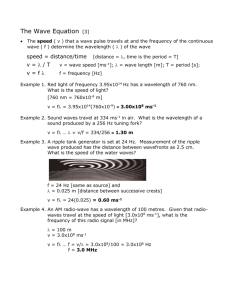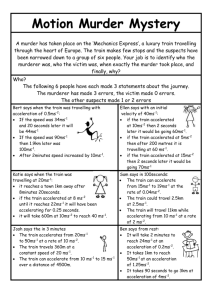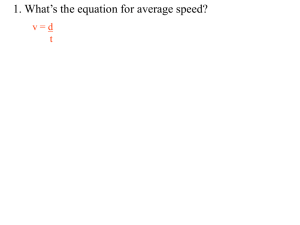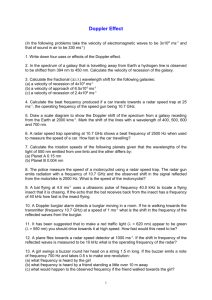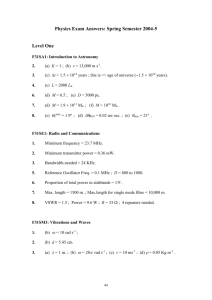Document 14671319
advertisement
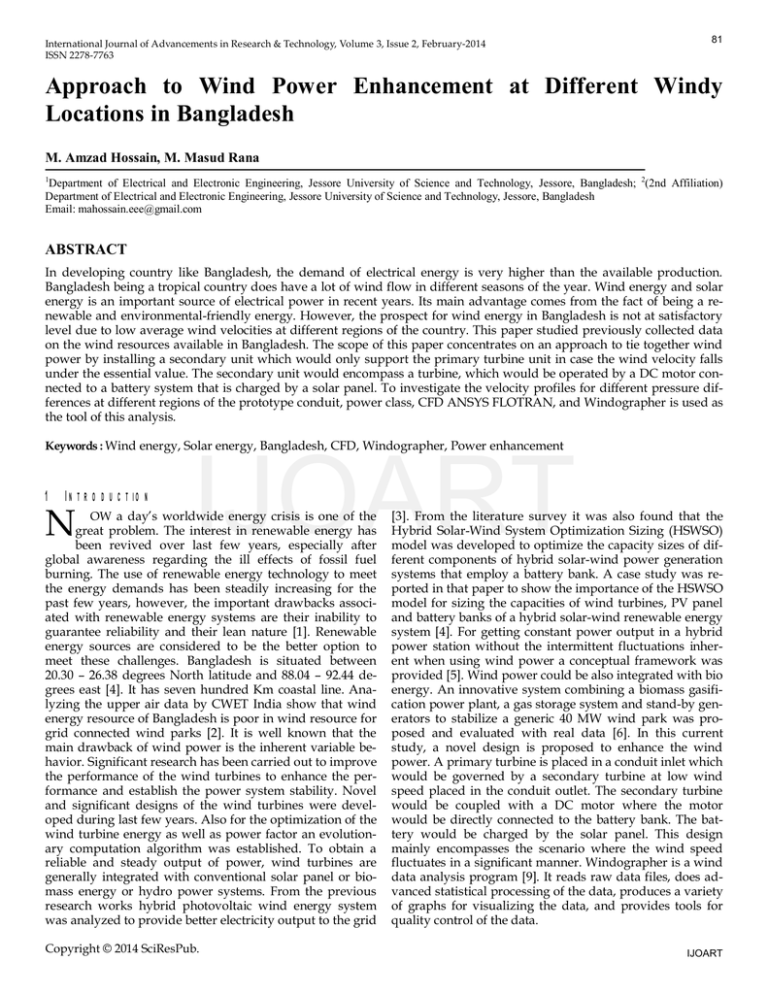
International Journal of Advancements in Research & Technology, Volume 3, Issue 2, February-2014 ISSN 2278-7763 81 Approach to Wind Power Enhancement at Different Windy Locations in Bangladesh M. Amzad Hossain, M. Masud Rana 1 Department of Electrical and Electronic Engineering, Jessore University of Science and Technology, Jessore, Bangladesh; 2(2nd Affiliation) Department of Electrical and Electronic Engineering, Jessore University of Science and Technology, Jessore, Bangladesh Email: mahossain.eee@gmail.com ABSTRACT In developing country like Bangladesh, the demand of electrical energy is very higher than the available production. Bangladesh being a tropical country does have a lot of wind flow in different seasons of the year. Wind energy and solar energy is an important source of electrical power in recent years. Its main advantage comes from the fact of being a renewable and environmental-friendly energy. However, the prospect for wind energy in Bangladesh is not at satisfactory level due to low average wind velocities at different regions of the country. This paper studied previously collected data on the wind resources available in Bangladesh. The scope of this paper concentrates on an approach to tie together wind power by installing a secondary unit which would only support the primary turbine unit in case the wind velocity falls under the essential value. The secondary unit would encompass a turbine, which would be operated by a DC motor connected to a battery system that is charged by a solar panel. To investigate the velocity profiles for different pressure differences at different regions of the prototype conduit, power class, CFD ANSYS FLOTRAN, and Windographer is used as the tool of this analysis. IJOART Keywords : Wind energy, Solar energy, Bangladesh, CFD, Windographer, Power enhancement 1 INTRODUCTION N OW a day’s worldwide energy crisis is one of the great problem. The interest in renewable energy has been revived over last few years, especially after global awareness regarding the ill effects of fossil fuel burning. The use of renewable energy technology to meet the energy demands has been steadily increasing for the past few years, however, the important drawbacks associated with renewable energy systems are their inability to guarantee reliability and their lean nature [1]. Renewable energy sources are considered to be the better option to meet these challenges. Bangladesh is situated between 20.30 – 26.38 degrees North latitude and 88.04 – 92.44 degrees east [4]. It has seven hundred Km coastal line. Analyzing the upper air data by CWET India show that wind energy resource of Bangladesh is poor in wind resource for grid connected wind parks [2]. It is well known that the main drawback of wind power is the inherent variable behavior. Significant research has been carried out to improve the performance of the wind turbines to enhance the performance and establish the power system stability. Novel and significant designs of the wind turbines were developed during last few years. Also for the optimization of the wind turbine energy as well as power factor an evolutionary computation algorithm was established. To obtain a reliable and steady output of power, wind turbines are generally integrated with conventional solar panel or biomass energy or hydro power systems. From the previous research works hybrid photovoltaic wind energy system was analyzed to provide better electricity output to the grid Copyright © 2014 SciResPub. [3]. From the literature survey it was also found that the Hybrid Solar-Wind System Optimization Sizing (HSWSO) model was developed to optimize the capacity sizes of different components of hybrid solar-wind power generation systems that employ a battery bank. A case study was reported in that paper to show the importance of the HSWSO model for sizing the capacities of wind turbines, PV panel and battery banks of a hybrid solar-wind renewable energy system [4]. For getting constant power output in a hybrid power station without the intermittent fluctuations inherent when using wind power a conceptual framework was provided [5]. Wind power could be also integrated with bio energy. An innovative system combining a biomass gasification power plant, a gas storage system and stand-by generators to stabilize a generic 40 MW wind park was proposed and evaluated with real data [6]. In this current study, a novel design is proposed to enhance the wind power. A primary turbine is placed in a conduit inlet which would be governed by a secondary turbine at low wind speed placed in the conduit outlet. The secondary turbine would be coupled with a DC motor where the motor would be directly connected to the battery bank. The battery would be charged by the solar panel. This design mainly encompasses the scenario where the wind speed fluctuates in a significant manner. Windographer is a wind data analysis program [9]. It reads raw data files, does advanced statistical processing of the data, produces a variety of graphs for visualizing the data, and provides tools for quality control of the data. IJOART 82 International Journal of Advancements in Research & Technology, Volume 3, Issue 2, February-2014 ISSN 2278-7763 2 WIND DATA IN BANGLADESH The prospect for wind energy in Bangladesh is not at satisfactory level due to low average wind velocities at different regions of the country. However, there are some places in Bangladesh like coastal areas where wind speed is relatively higher for harnessing power but is not constant for all the time during power extraction. So the primary concentration would be to extract power at relatively low wind speed. In this paper, an innovative approach is shown with clear description to enhance the wind power and simulation of the design is also provided. Finally a comparative feasibility analysis of the modified system with the conventional wind turbine is given with elaborate mathematical explanations. The Table I gives information about the monthly variation of wind speed in some places of Bangladesh. It is clear that the wind speed is not constant for power extraction at promising level during a certain year, rather, it fluctuates in a significant manner. It shows that during few months for certain regions in the country power extraction from the wind turbine is not at all possible. Table I Monthly Average speeds measured at 30m height Month Measured Measured Measured Average AverageAverage wind speed wind speed wind speed in Saint in Cox’s Bain Patenga Martin at zar at 30m at 30m 30m height height height 4.09 ms-1 3.95 ms-1 January 4.48 ms-1 up the rotor speed. From the generator, the electrical energy is transmitted to a utility grid either directly or through an electrical energy conversion stage that produces constant-frequency, constant-amplitude voltage suitable for interface to the utility [2]. Region I, Where the wind speed is below the cut-in speed. The power in the wind is insufficient to overcome the power losses within the turbine system. Region II, Where the wind speed is between the cut-in speed and the rated wind speed. Generally, the rated wind speed is the wind speed at which the maximum output power of the generator is reached. Region III, Where the wind speed is between the rated wind speed and the cutout speed. The cut-out speed is the maximum wind speed at which the turbine is allowed to deliver energy. Usually, the cut-out speed is limited by engineering design and safety constraints [2]. IJOART 4.02 ms-1 4.62 ms-1 March 4.54 ms-1 April 4.09 ms-1 May 5.37 ms-1 3.82 ms-1 4.79 ms-1 June 6.47 ms 5.23 ms 4.87 ms July 5.86 ms-1 5.32 ms-1 4.98 ms-1 August 5.98 ms-1 4.93 ms-1 4.39 ms-1 September 4.77 ms-1 4.42 ms-1 4.11 ms-1 October 4.41 ms-1 4.09 ms-1 3.79 ms-1 November 3.83 ms-1 3.81 ms-1 3.63 ms-1 December 4.31 ms-1 3.97 ms-1 3.48 ms-1 -1 3.96 ms-1 -1 3.73 ms-1 3.56 ms-1 4.23 ms-1 -1 3 WIND TURBINE SYSTEM The In a wind turbine system, the kinetic energy in the wind is converted into rotational energy in a rotor of the wind turbine. The rotational energy is then transferred to a generator, either directly or through a gearbox for stepping Copyright © 2014 SciResPub. Fig. 1: Characteristic of a typical Wind turbine generator The output power of the wind turbine is given by the following equation [2]. Pm 12 C p ( , ) AV 3 (1) The Cp is the fraction of the upstream wind power, which is captured by the rotor blades. Performance coefficient Vs Tip speed ratio at different Pitch angle =0 X: 8.1 Y: 0.48 0.4 P e rfo rm a n c e c o e ffic ie n t (C p ) 4.17 ms-1 February =5 0.3 = 10 0.2 = 15 0.1 = 20 0 -0.1 0 5 10 Tip speed ratio of the rotor blade tip speed to wind speed ( ) Fig. 2: Performance coefficient vs. Tip speed ratio at different pitch angle 15 IJOART International Journal of Advancements in Research & Technology, Volume 3, Issue 2, February-2014 ISSN 2278-7763 From t he Cp- characteristics, for different values of the pitch angle , are illustrated above. The maximum value of Cp (Cp = 0 degree and for = 8.1. It has max = 0.48) is achieved for the maximum value of 0.59. The maximum power is extracted from the wind at that speed ratio. The theoretical maximum value of Cp is 0.59. In practical designs, the maximum achievable Cp is below 0.5 for high-speed, two-blade turbines, and between 0.2 and 0.4 for slow speed turbines with more blades [4]. 4 SCHEME FOR WIND POWER ENHANCEMENT 83 delivers the electrical power whereas the secondary unit gets the power from the DC motor connected to the battery bank. When the wind speed again reaches at the desired level then the DC motor will stop and act as a generator because of the natural wind flow through the secondary turbine. The overall power extraction as well as system efficiency is enhanced with the help of this proposed design. In the next two sections the feasibility of this proposed system is justified with simulation and mathematical calculations. 6 SIMULATION RESULTS ANALYSIS ANSYS FLOTRAN simulations were carried out with steady state, standard turbulent model for varying downstream diameters of the conduit with varying pressure differences. From the simulations results depicted in Fig. 4, downstream diameter of 0.6 meter with upstream and downstream pressure difference of 30 Pa was selected to be the preferred parameters as this would provide the cut-in velocity of 5 m/s in the upstream region of the conduit. Fig.4 depicts the air velocity profile with the selected parameters. IJOART Fig. 3: Schematic of the proposed modified design of the system. As shown in Fig. 3, the primary turbine and the secondary turbine would be set at the inlet and the outlet of the taper shaped conduit consecutively. The primary turbine would comprise a generator which would be installed inside the conduit. The secondary turbine would run by a DC motor which would be connected to the battery system that would be charged by the solar panel. A PV solar panel would be used as a back up source for the DC motor. When the wind speed would reach the desired level for power extraction the primary turbine would start to rotate and would give a certain power output. The wind would then pass through the conduit striking the blades of the auxiliary turbine with a relatively low energy compared with the inlet wind energy. The converging section of the conduit is helpful in increasing the air velocity that could be utilized to run the auxiliary unit effectively. Therefore power would also be produced by the auxiliary unit where the DC motor will act as a generator. Next when the wind speed goes down below the desired level then the secondary turbine will run with the help of DC motor to assist the primary turbine to rotate. In this case the primary turbine Copyright © 2014 SciResPub. IJOART 84 International Journal of Advancements in Research & Technology, Volume 3, Issue 2, February-2014 ISSN 2278-7763 7 FEASIBILITY ANALYSIS FOR MODIFIED SYSTEM Fig. 4: Upstream velocity vs. inlet diameter of the conduit for the outlet diameter of (a) 0.4m, (b) 0.6m, and (c) 0.8m. The feasibility analysis of the modified system is based on theoretical calculations. All conditions are assumed ideal. From Fig. 6, considering a specific scenario for the Cox’s Bazar region, the theoretical calculation for feasibility analysis was carried out. From the figure it can be seen that, in the Cox’s Bazar region cut-in speed could be achieved for the period of 12 hours for power extraction. However, for the remaining 12 hours, the wind speed is below the cut-in speed. Here, an analytical solution was attempted considering the cut-in speed as the maximum tolerance limit of 5 m/s. The upper curve to lower curve in Fig. 4 (a), (b), and (c) represent 30Pa pressure difference, 25Pa pressure difference, 20Pa pressure difference, 15Pa pressure difference, 10Pa pressure difference. Fig. 6: Diurnal variation of wind speed in some places of Bangladesh IJOART Fig. 5: Velocity profile of air through the conduit (0.6m outlet diameter, pressure difference 30 Pa). IJOART Transactions accepts supplemental materials for review with regular paper submissions. These materials may be published on our Digital Library with the electronic version of the paper and are available for free to Digital Library visitors. Please see our guidelines below for file specifications and information. Any submitted materials that do not follow these specifications. . 4 CONCLUSION Conceptional design has been proposed in this research work which was validated by the ideal theoretical formulations. Simulation results showed the wind speed variations through the conduit. Wind power could be enhanced by a certain amount by implementing this novel design. This feasible design could be imCopyright © 2014 SciResPub. IJOART International Journal of Advancements in Research & Technology, Volume 3, Issue 2, February-2014 ISSN 2278-7763 85 plemented where wind speed is not at satisfactory level like Bangladesh. It would be beneficial if energy of the wind can be extracted at relatively low speed. Further research can be maderegarding the prototype manufacturing and testing as well as the economical viability of the overall system would also be analyzed. It is concluded that Permanent Magnet wind generator topology provides a compact and effective solution in small scale wind industry applications, which can be designed, analyzed and tested in few selected windy locations in Bangladesh. REFERENCES [1] International Energy Agency, 1995, “Wind Energy Annual Report,” International Energy Agency Report by NREL, March 1995 [2] Mohammad Golam Kibria Khan, Talha Rahman and M.M. Alam, “Wind Energy in Bangladesh: Prospects and Utilization Initiatives”, 3rd ICECE 2004, December, Dhaka, Bangladesh [3] N. B. Urli, M. Kamenski, Hybrid photovoltaic/wind grid-connected power plants in Croatian renewable energy program, Renewable Energy, Volume 15, Issues 1-4, September-December 1998, Pages 594-597. IJOART [4] Hongxing Yang, Lin Lu, Wei Zhou, A novel optimization sizing model for hybrid solar-wind power generation system, Solar Energy, Volume 81, Issue 1, January 2007, Pages 76-84. [5] O. A. Jaramillo, M. A. Borja, J. M. Huacuz, Using hydropower to complement wind energy: a hybrid system to provide firm power, Renewable Energy, Volume 29, Issue 11, September 2004, Pages 1887-1909. [6] A. Pérez-Navarro, D. Alfonso, C. Álvarez, F. Ibáñez, C. Sánchez, I. Segur, Hybrid biomass-wind power plant for reliable energy generation, Renewable Energy, Volume 35, Issue 7, July 2010, Pages 1436-1443. [7] Sultan Ahmmed and M. Quamrul Islam, Wind Power for Rural Areas of Bangladesh, 3rd International Conference on Electrical & Computer Engineering, ICECE 2004, Pages 192-197, 28-30 December 2004, Dhaka, Bangladesh. [8] A. C. Mandal, M. Q. Islam, Aerodynamics and Design of Wind Turbines, ISBN 984-31-0923-0, September 15, 2001, Published by BUET, Dhaka-1000. [9] Windographer Accessed April, 2012. (www.mistaya.ca/windographer), Copyright © 2014 SciResPub. IJOART

